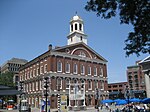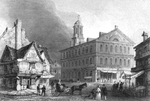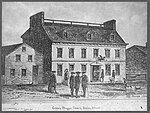A Once and Future Shoreline
Boston National Historical ParkCultural history of BostonLandmarks in BostonPublic art in MassachusettsSeashells in art

A Once and Future Shoreline is a permanent public artwork that graphically marks the edge of Boston Harbor, circa 1630, into the granite paving blocks of the plaza on the West side of the historic Faneuil Hall building. The 850-foot-long artwork depicts the location of a pre-colonial shoreline by graphically etching silhouettes of materials that are found typically along the high tide line. The artwork offers a way to engage the imagination in an exploration of the changes to this now urban site from a salty tidal marsh, to an active pedestrian plaza.
Excerpt from the Wikipedia article A Once and Future Shoreline (License: CC BY-SA 3.0, Authors, Images).A Once and Future Shoreline
Faneuil Hall Square, Boston
Geographical coordinates (GPS) Address Website Nearby Places Show on map
Geographical coordinates (GPS)
| Latitude | Longitude |
|---|---|
| N 42.36 ° | E -71.05625 ° |
Address
Project Management Academy
Faneuil Hall Square 4
02109 Boston
Massachusetts, United States
Open on Google Maps









